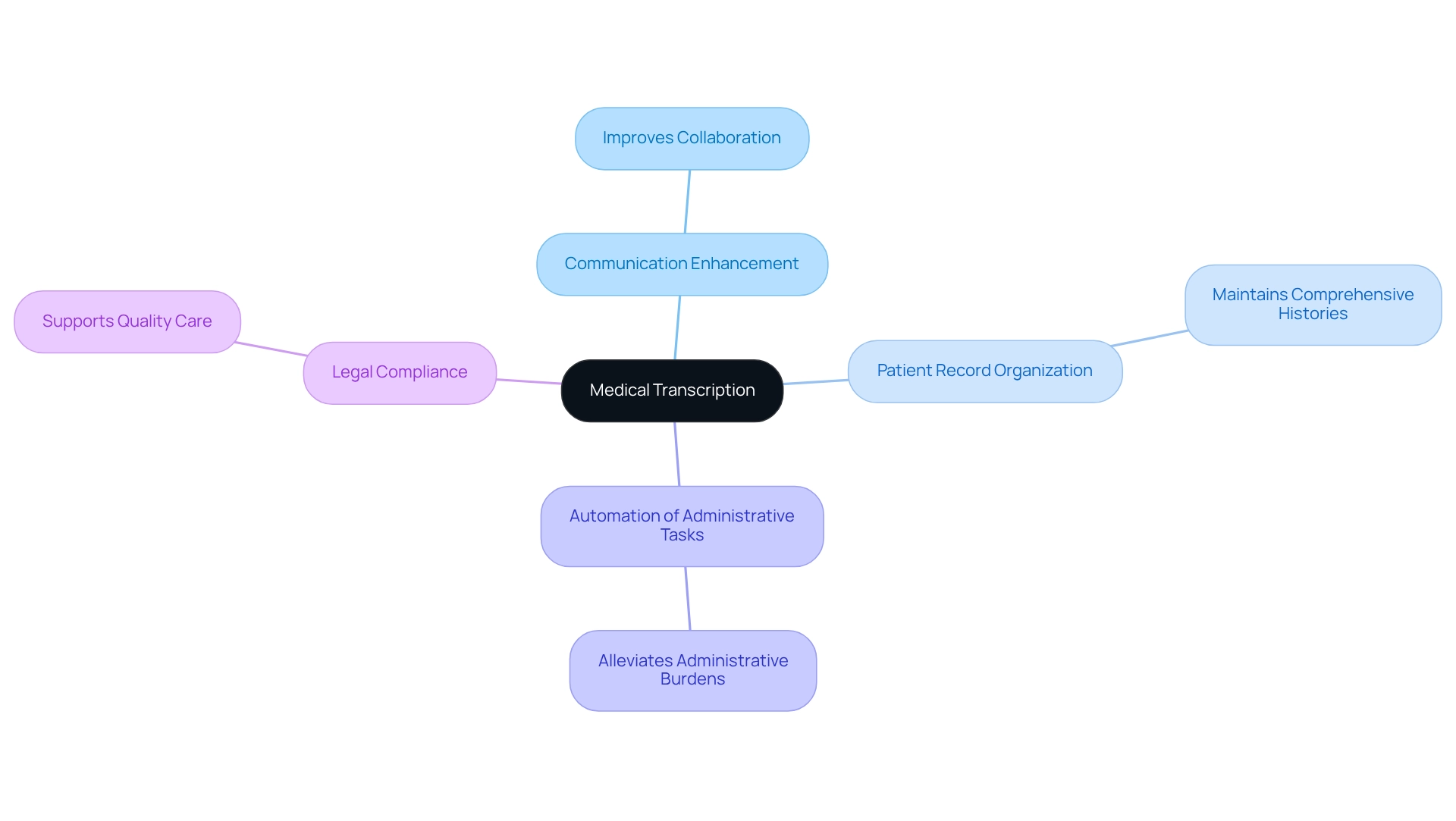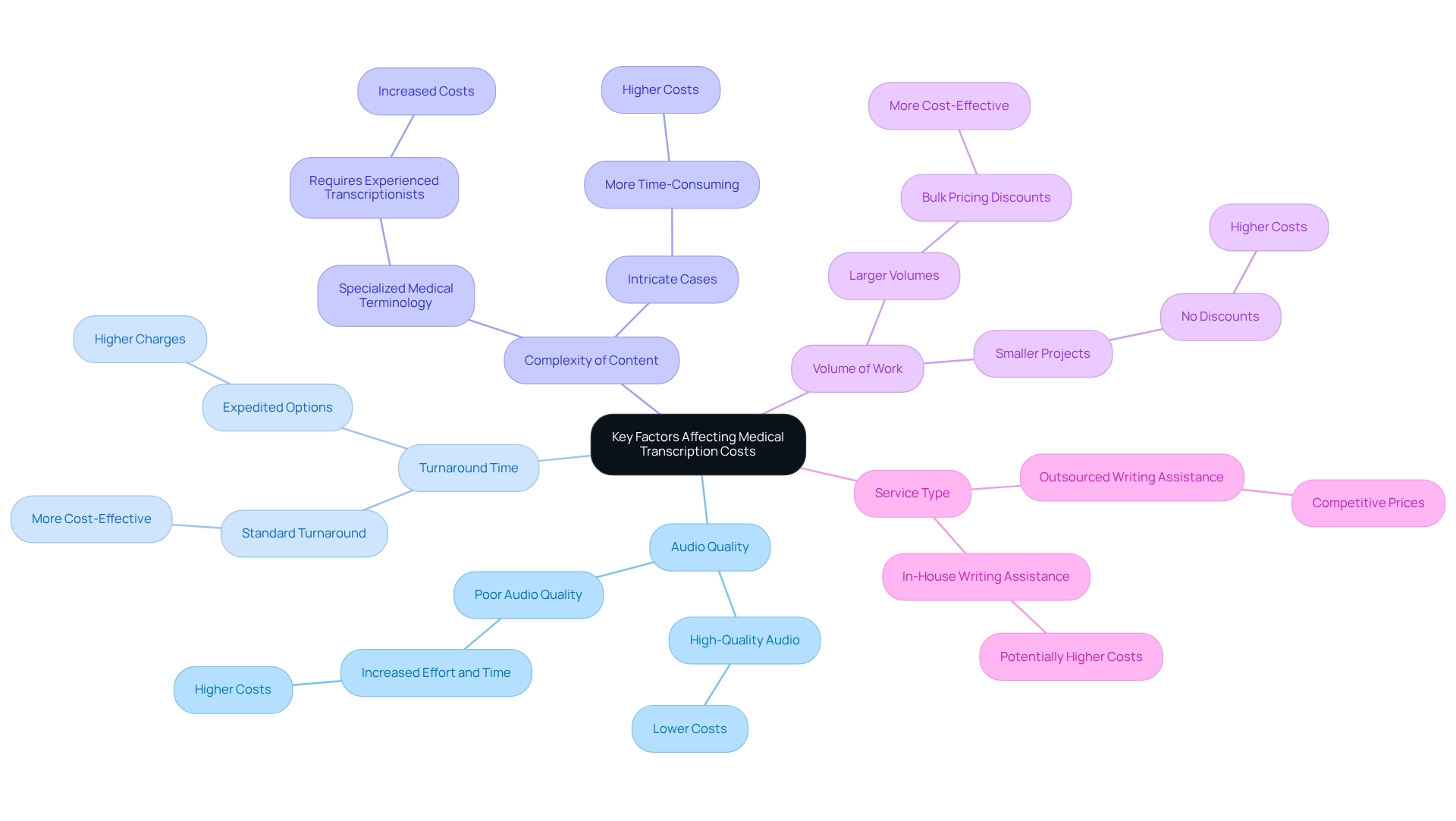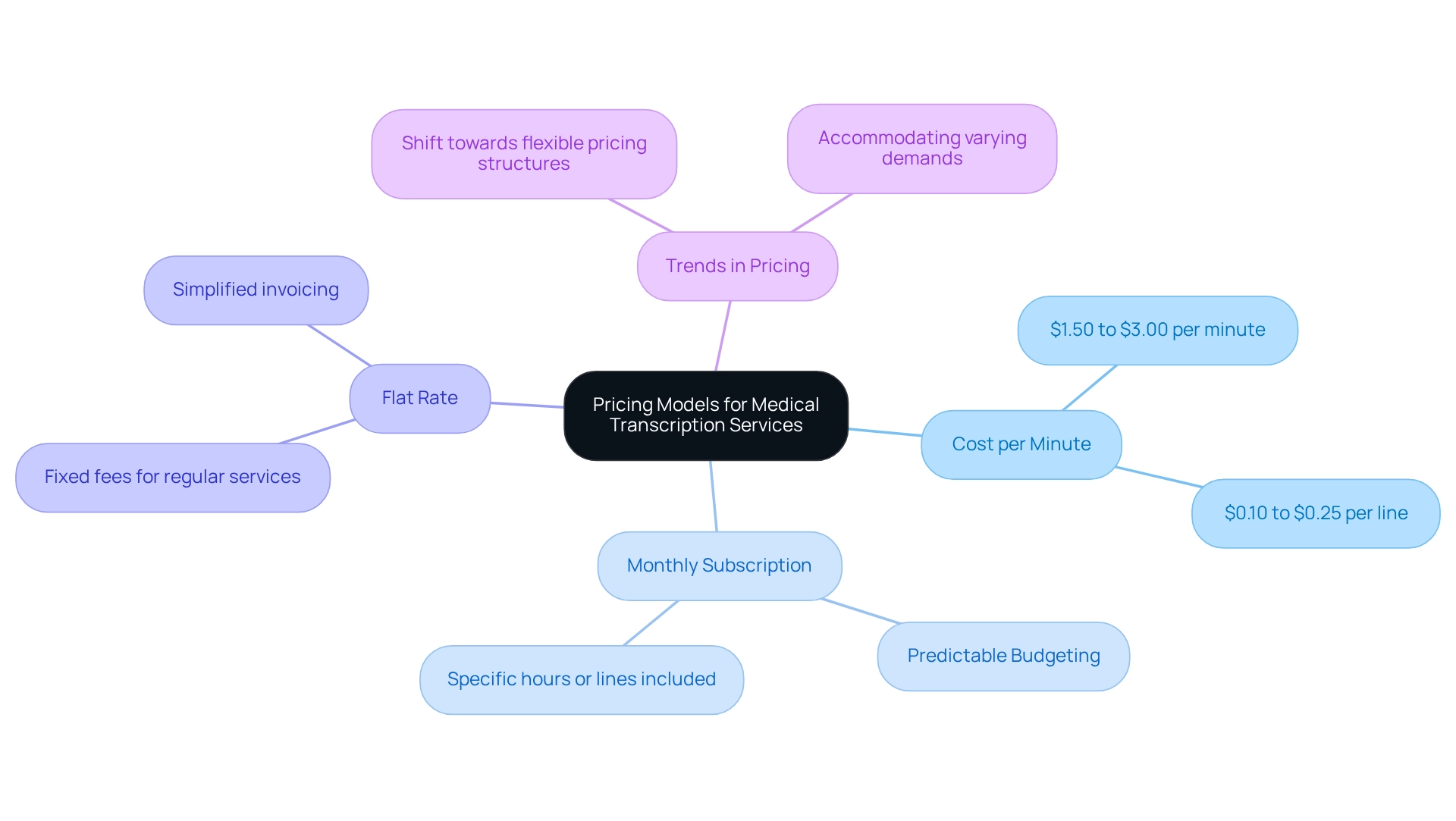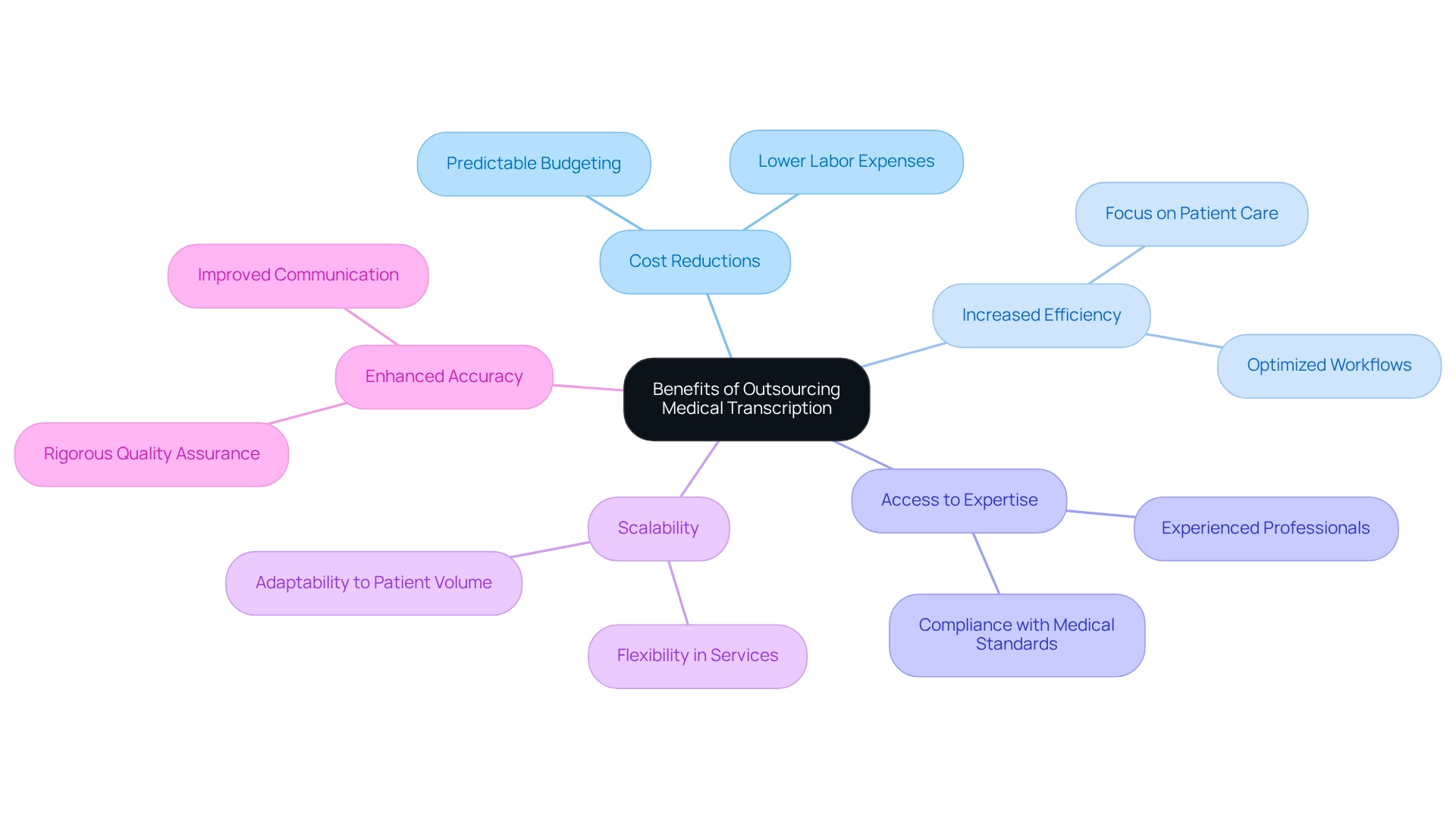Overview
Healthcare providers often face significant emotional challenges due to the complexities of documentation. The burdens of administrative tasks can detract from the vital focus on patient care. Understanding the main cost factors for medical transcription services can help alleviate some of this pressure. These factors include:
- Audio quality
- Turnaround time
- Content complexity
- Volume of work
- Choice between outsourced and in-house services
Consider how clearer audio can lead to reduced costs, allowing providers to allocate resources more effectively. Urgent requests, while sometimes necessary, often increase charges, creating additional stress. Moreover, complex content necessitates skilled transcriptionists, which can further impact budgets. By recognizing these elements, providers can make informed decisions about their documentation needs, ultimately enhancing their ability to care for patients.
Reflect on how these insights can empower your practice. Are there areas where you could streamline processes to focus more on patient interaction? By addressing these factors, you can not only improve efficiency but also foster a more compassionate healthcare environment. Let’s take steps together to ensure that your documentation supports, rather than hinders, your mission to provide exceptional care.
Introduction
In the complex world of healthcare, we understand that accurate and efficient documentation is not just a necessity; it is vital for effective patient care. Medical transcription acts as a crucial link between healthcare professionals and the care they provide, transforming spoken words into organized written records. This transformation enhances communication and streamlines processes, ultimately benefiting patient outcomes.
As the demand for high-quality patient documentation rises, it's essential for healthcare providers to grasp the factors influencing transcription costs and the various pricing models available. These insights can alleviate some of the administrative burdens that often weigh heavily on providers, allowing them to focus more on what truly matters: patient care.
Furthermore, the trend towards outsourcing transcription services presents a wealth of advantages. Imagine experiencing cost savings, increased efficiency, and access to specialized expertise—all contributing to a smoother workflow. This article explores the multifaceted role of medical transcription in healthcare, shedding light on its significance, cost determinants, pricing structures, and the many benefits of outsourcing. Together, these elements play a crucial role in enhancing patient care and ensuring operational success.
We invite you to delve deeper into this topic, as understanding these aspects can empower you to make informed decisions that positively impact your practice and your patients.
Define Medical Transcription and Its Role in Healthcare
Medical dictation is more than just a process; it’s a lifeline for healthcare professionals. By converting voice recordings into written text, this essential service ensures that patient records are accurately documented. Have you ever considered how this impacts communication among providers? It truly enhances collaboration, ultimately improving patient care.
When dictated notes are transformed into organized reports, they play a vital role in maintaining , treatment plans, and follow-up care instructions. This organization is crucial, especially when administrative burdens can weigh heavily on healthcare providers. Automating tasks like appointment scheduling and billing alleviates the stress of time-consuming processes, allowing providers to focus on what truly matters—their patients.
The precision and effectiveness of medical documentation are vital for and legal adherence in medical environments. This means doctors can dedicate more time to delivering high-quality care. Isn’t it reassuring to know that statistics show methods employing documentation assistance have led to remarkable enhancements in patient follow-up and compliance with treatment plans? This highlights the considerable influence of medical documentation on healthcare delivery.
In a world where every detail counts, let’s embrace the power of medical dictation. It not only supports healthcare providers but also fosters a nurturing environment for patients, ensuring they receive the best care possible.

Identify Key Factors Affecting Medical Transcription Costs
Several key factors significantly influence cost associated with medical documentation services, and understanding these factors can alleviate some of the burdens you face.
- Audio Quality: Have you ever noticed how the clarity of recordings plays a crucial role in determining conversion costs? High-quality audio with minimal background noise can simplify the documentation process, which can lead to a lower medical transcription cost. On the other hand, poor audio quality requires additional effort and time, which can increase the medical transcription cost.
- Turnaround Time: The urgency of your requests also directly impacts pricing. While standard turnaround times are typically more cost-effective, the medical transcription cost for expedited options often results in higher charges due to the need for prompt attention.
- Complexity of Content: Consider the complexity of the content you need transcribed. Transcriptions involving specialized medical terminology or intricate cases require more experienced transcriptionists, which can increase the medical transcription cost. The expertise needed to accurately capture complex information is a significant factor influencing the medical transcription cost.
- Volume of Work: The quantity of writing tasks you have can influence pricing as well. Larger volumes often qualify for bulk pricing discounts, making them more cost-effective, while smaller projects may not benefit from such reductions in medical transcription cost.
- Service Type: Finally, think about the selection between outsourced and in-house writing assistance. This choice can lead to differing medical transcription cost structures. Outsourced options may present competitive prices, but it’s essential to assess the overall worth and quality of assistance when making your decision.
By comprehending these aspects, you can make informed choices related to your documentation requirements. This understanding ultimately improves not just operational efficiency but also enhances patient care, allowing you to focus more on what truly matters.

Explore Pricing Models for Medical Transcription Services
Healthcare providers often face emotional challenges due to the demands of their roles, particularly when it comes to managing administrative tasks. Medical transcription services can alleviate some of these burdens, allowing professionals to focus more on patient care. Understanding the different pricing models available, such as the medical transcription cost per minute of audio, can be a crucial step toward finding the right solution for your needs. As of 2025, the medical transcription cost per minute of audio conversion is moving towards $1.50 to $3.00, depending on the provider's reliability and speed. A standard line is defined as 65 characters, including spaces, translating to approximately 12 to 14 words. This model can vary significantly based on content complexity, with typically ranging from $0.10 to $0.25 per line.
- Monthly Subscription: For practices with high transcription needs, a subscription model may help manage medical transcription costs while providing predictable budgeting. This method often includes a specific number of hours or lines each month, making it an appealing choice for larger medical organizations.
- Flat Rate: Some suppliers may provide a fixed fee for particular services, simplifying invoicing and financial planning. This model can be especially beneficial for regular documentation tasks, ensuring consistent medical transcription cost regardless of workload. As the industry evolves, current trends indicate a shift toward more flexible pricing structures to accommodate the varying demands of healthcare providers. Understanding these models is essential for making informed choices regarding the medical transcription cost related to text conversion solutions. Quality assurance plays a vital role in ensuring accurate records, highlighting the importance of precision in this field.
For instance, CosmaNeura's AI system illustrates how technology can enhance efficiency and accuracy in medical documentation, ultimately supporting healthcare professionals. Additionally, platforms like Sonix offer free trials, allowing users to explore features before committing to a subscription. This can be a significant factor in your decision-making process.
By recognizing the challenges you face and exploring these transcription options, you can find a solution that not only meets your needs but also enhances your ability to provide quality care.

Evaluate the Benefits of Outsourcing Medical Transcription
Outsourcing medical transcription offers significant advantages for healthcare providers, addressing the emotional challenges they face in managing administrative burdens.
Cost Reductions: By outsourcing writing services, medical providers can significantly lower labor expenses related to hiring and training internal writers. This shift not only alleviates overhead but also fosters more predictable budgeting, allowing providers to focus on what truly matters—patient care.
Increased Efficiency: When documentation tasks are assigned to specialists, healthcare professionals can devote their time to patient care rather than administrative responsibilities. This optimization of workflows leads to enhanced productivity, ultimately benefiting both providers and patients.
Access to Expertise: Specialized documentation solutions employ experienced professionals who ensure high precision and compliance with medical standards. This expertise is vital for maintaining compliance and improving the quality of documentation, which directly impacts patient outcomes.
Scalability: Outsourcing provides the flexibility to adjust services based on the practice's needs, accommodating fluctuations in patient volume without the burden of maintaining a permanent workforce. This adaptability is crucial in .
Enhanced Accuracy: Professional documentation services implement rigorous quality assurance processes, resulting in fewer errors and higher-quality documentation. This precision is essential for effective communication among medical professionals, contributing to improved patient care outcomes.
A case study on the standardization of medical records illustrates these benefits. Consistent and precise medical documentation not only enhances readability but also improves accessibility for medical practitioners. This ultimately leads to better communication and higher quality of care.
As healthcare providers increasingly embrace advanced technologies—such as blockchain and encryption for data security—the importance of reliable documentation services will continue to grow. By 2025, the integration of these technologies will further highlight the necessity for high-quality documentation that meets evolving compliance standards, including HIPAA regulations. Thus, outsourcing medical transcription cost is not merely a cost-effective solution; it is a strategic move towards operational excellence and improved patient care. How can you begin this journey towards better documentation today?

Conclusion
The multifaceted role of medical transcription in healthcare is truly vital. By converting voice recordings into accurate written records, transcription services enhance communication among healthcare providers and streamline administrative processes, ultimately improving patient care. Essential documentation is crucial for maintaining comprehensive patient histories and ensuring effective treatment plans, underscoring the need for high-quality transcription.
Healthcare providers often face emotional challenges, particularly when administrative burdens impact patient care. Understanding the factors influencing transcription costs—such as audio quality, turnaround time, complexity of content, volume of work, and service type—empowers providers to make informed decisions. This knowledge can enhance operational efficiency and reduce the stress of administrative tasks. Exploring various pricing models allows providers to choose the most suitable option for their specific needs, ensuring they receive the best value for their investment.
Outsourcing medical transcription presents significant advantages. Consider these benefits:
- Cost savings
- Increased efficiency
- Access to specialized expertise
By leveraging these services, healthcare professionals can focus on delivering high-quality patient care while enjoying the enhanced accuracy and scalability that professional transcription offers. As the healthcare landscape continues to evolve, embracing reliable transcription services will be vital for maintaining compliance and achieving operational excellence.
In summary, investing in effective medical transcription solutions is not just a logistical decision; it is a strategic imperative that directly impacts patient outcomes and the overall success of healthcare practices. Let’s embrace this opportunity together for a brighter future in patient care.




